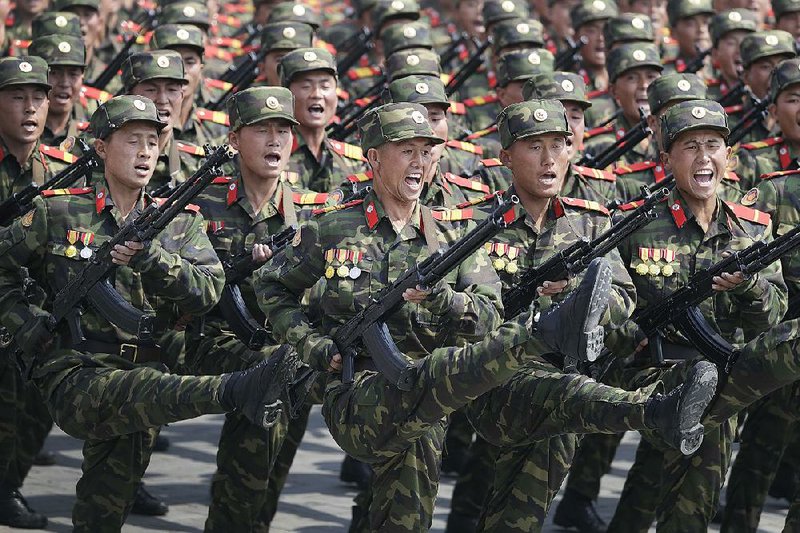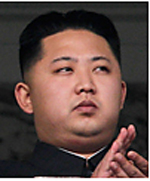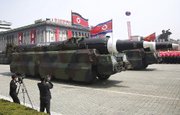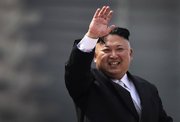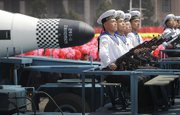SEOUL, South Korea -- North Korea launched a ballistic missile this morning from near its submarine base in Sinpo on its east coast, but the launch failed, according to the South Korean military.
The missile appeared to have been launched to show off the military capabilities of the North's leader, Kim Jong Un, as a fleet of U.S. warships approached his country to deter provocations. The attempted launch occurred a day after the North held its annual parade in celebration of the 1912 birth of Kim's grandfather, Kim Il Sung, North Korea's founding ruler.
"U.S. Pacific Command detected and tracked what we assess was a North Korean missile launch at 11:21 a.m. Hawaii time April 15. The launch of the ballistic missile occurred near Sinpo," said Cmdr. Dave Benham, a spokesman for U.S. Pacific Command.
The missile blew up almost immediately, and the type of missile involved was still being assessed, he said.
[PRESIDENT TRUMP: Timeline, appointments, executive orders + guide to actions in first 100 days]
"U.S. Pacific Command is fully committed to working closely with our allies in the Republic of Korea and in Japan to maintain security," Benham said.
President Donald Trump did not immediately comment on the failed launch. In a statement, Defense Secretary James Mattis said Trump and his military team "are aware of North Korea's most recent unsuccessful missile launch. The president has no further comment."
On Saturday, what analysts say were three types of intercontinental ballistic missiles rolled through Pyongyang, the North's capital. During the parade, Kim watched from a platform surrounded by elderly military officers as long columns of goose-stepping soldiers marched through a large plaza, accompanied by a fleet of tanks, missiles and rocket tubes.
Saturday was the 105th anniversary of Kim Il Sung's birth. Kim Il Sung's birthday, called the Day of the Sun, is the North's most important holiday and a key moment for scoring propaganda points.
The United States, China and other regional powers had feared that North Korea might mark the occasion by conducting its sixth nuclear test or by launching an intercontinental ballistic missile. The United States sent a naval strike group to the coast of the Korean Peninsula in a show of force, marking the first showdown between Kim and Trump.
U.S. Vice President Mike Pence is scheduled to arrive in Seoul, South Korea, today during an Asian swing.
But no seismic tremor emanated Saturday from the North's nuclear test site, where recent satellite photographs have shown what appeared to be preparations for an underground detonation.
Instead of a a nuclear test or a missile launch, Kim Jong Un seemed to have decided to celebrate with a military parade meant to demonstrate his missile capabilities.
Kim is aware that the threat that he could soon possess a missile capable of striking the continental United States is Washington's biggest concern, and both the number and the variety of missiles he showed Saturday appeared to send the message that a pre-emptive strike against his might would be fruitless.
Kim did not speak during the annual parade, which involved tens of thousands of people, but a top official warned that the North would stand up to any threat posed by the United States.
Choe Ryong Hae said Trump was guilty of "creating a war situation" on the Korean Peninsula by dispatching U.S. forces to the region.
Kim, a leader in his 30s who took power in late 2011 after the death of his father, Kim Jong Il, emphasizes nuclear weapons as the foundation of his national defense strategy. Under his watch, North Korea has aggressively pursued a goal of putting a nuclear warhead on an intercontinental ballistic missile capable of reaching the U.S. mainland.
North Korea has long insisted that its goal is peace -- and survival -- with the growing arsenal a way to ensure that the government in Pyongyang is not easily overthrown.
North Korea saw the toppling of Saddam Hussein in Iraq and Moammar Gadhafi in Libya -- neither of whom had nuclear weapons -- as proof of the weapons' power.
"It will be the largest of miscalculations if the United States treats us like Iraq and Libya, which are living out miserable fates as victims of aggression, and Syria, which didn't respond immediately even after it was attacked," said a Friday statement by the general staff of the North Korean army, according to the official Korean Central News Agency.
Other military hardware the North paraded Saturday included tanks, multiple rocket launchers and artillery, as well as a solid-fuel missile designed to be fired from submarines. Also on display was a powerful midrange missile that can potentially reach U.S. air bases in Guam, which outside analysts call a "Musudan," as well as a new solid-fuel midrange missile that can be fired from land mobile launchers, making them harder to detect before launch.
Some analysts doubt that the country has mastered the skills to build a warhead that can survive re-entry from space or one small enough to mount on a long-range missile. They said the intercontinental ballistic missiles that had been displayed in recent North Korean military parades might have been mockups of systems still under development.
In a New Year's Day speech, however, Kim claimed that his country was in the "final stage" of preparations for its first intercontinental ballistic missile test. Trump responded with a Twitter message saying that the launching would never be permitted to happen.
missiles in tubes
One of the three intercontinental ballistic missiles analysts identified in North Korea's Saturday parade was the KN-08, which the North first displayed in a 2012 parade and is widely believed to have been its first attempt at an intercontinental ballistic missile.
Making their parade debut on launcher trucks were very large missiles encased in tubes or canisters. Analysts said the tubes appeared to have been designed for two other kinds of long-range ballistic missiles. There were multiple examples of each tube; it was impossible to see what was in them, but analysts said it was likely that they contained missiles that were either completed or under development.
Militaries use such canisters to "cold launch" missiles, ejecting them high into the air before their fuel ignites. If North Korea perfected that technology, it could better protect its mobile missiles from environmental damage while being driven around and from fiery exhaust during launch. The method also can make missiles harder to detect once fired.
"They're not just showing off missiles that are hard to build," said Jeffrey Lewis, a North Korea specialist at the Middlebury Institute of International Studies at Monterey, in California. "They're showing off all the associated technologies you need for credible deployments."
Kim Dong-yub, a missile expert at the Institute for Far Eastern Studies at Kyungnam University in Seoul, said one kind of tube appeared to be for the KN-14, a modified version of the KN-08 that was first displayed in a parade in 2015, during which the North claimed that its missiles were tipped with nuclear warheads.
The other tube design was new to the analysts.
"Given the size, it looks like it contains a new ballistic missile with a range of at least [3,700 miles]" -- making it potentially an intercontinental threat, said Shin In-kyun, a military expert who runs the Korea Defense Network, a civic group specializing in military affairs. "Officials in the region will scramble to figure out whether this is a new solid-fuel, long-range ballistic missile the North was believed to be developing."
Aside from improving the technology, North Korean missile and nuclear tests are seen by outside analysts partly as efforts to bolster the domestic image of Kim Jong Un and apply political pressure on Seoul and Washington.
Kim has overseen three nuclear tests and a string of missile and rocket launches since taking over.
Another missile test from Sinpo failed earlier this month, when the rocket spun out of control and plunged into the ocean. That launch came shortly before Trump's first meeting with Chinese leader Xi Jinping. China is North Korea's only major ally.
The extended-range Scud missile in that earlier launch suffered an in-flight failure and fell into the sea off North Korea's east coast, according to U.S. imagery and assessments.
Despite today's failure, the North's previous claim to have used "standardized" warheads has led to worries that it was making headway in its push to develop small and sophisticated warheads to be topped on long-range missiles.
The United States, South Korea and other countries have vowed to apply more pressure on the North, but so far nothing has worked to stop Pyongyang's nuclear program.
Information for this article was contributed by Choe Sang-Hun, David E. Sanger and William J. Broad of The New York Times; by Kanga Kong of Bloomberg News; and by Tim Sullivan, Foster Klug and Hyung-Jin Kim of The Associated Press.
A Section on 04/16/2017
